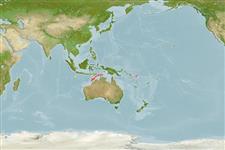>
Gadiformes (Cods) >
Macrouridae (Grenadiers or rattails)
Etymology: Coelorinchus: Greek, koilos = a hollow + Greek, rhyngchos = jaw (Ref. 45335).
More on authors: Iwamoto & Williams.
Environment: milieu / climate zone / depth range / distribution range
Ekologi
marina djupbottenlevande; djupintervall 179 - 320 m (Ref. 35909). Deep-water; 9°S - 16°S
Eastern Indian Ocean and Western Pacific: North West Australia to Arafura Sea.
Size / Vikt / Age
Maturity: Lm ? range ? - ? cm
Max length : 21.0 cm TL hane/ej könsbestämd; (Ref. 35909)
A benthic species found on the continental shelf and slope (Ref. 75154).
Life cycle and mating behavior
Maturities | Reproduktion | Spawnings | Egg(s) | Fecundities | Larver
Iwamoto, T. and A. Williams, 1999. Grenadiers (Pisces, Gadiformes) from the continental slope of western and northwestern Australia. Proc. Calif. Acad. Sci. 51(3):105-243. (Ref. 35909)
IUCN Red List Status (Ref. 130435)
Threat to humans
Harmless
Human uses
Verktyg
Special reports
Download XML
Internet-källor
Estimates based on models
Preferred temperature (Ref.
123201): 12.7 - 17.7, mean 15 °C (based on 15 cells).
Phylogenetic diversity index (Ref.
82804): PD
50 = 0.5000 [Uniqueness, from 0.5 = low to 2.0 = high].
Bayesian length-weight: a=0.00251 (0.00128 - 0.00492), b=3.19 (3.03 - 3.35), in cm total length, based on LWR estimates for this Genus-body shape (Ref.
93245).
Trofisk nivå (Ref.
69278): 3.4 ±0.5 se; based on size and trophs of closest relatives
Resiliens (Ref.
120179): Mellan, lägsta populationsfördubblingstid 1,4-4,4 år (Preliminary K or Fecundity.).
Fishing Vulnerability (Ref.
59153): Low vulnerability (11 of 100).
